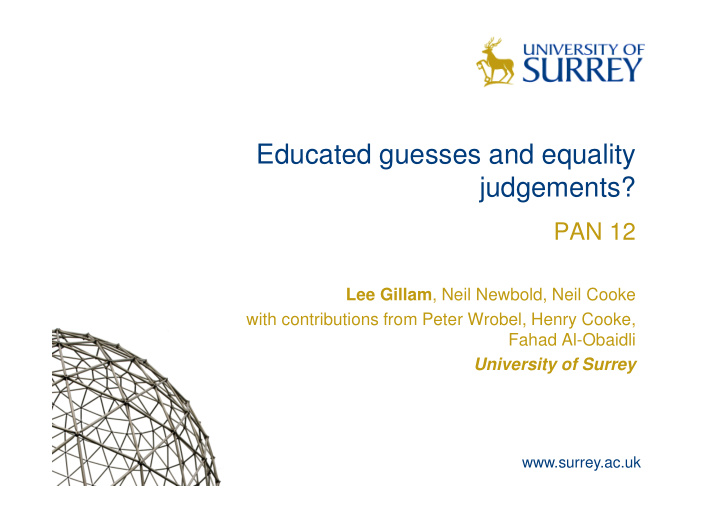



Educated guesses and equality judgements? PAN 12 Lee Gillam , Neil Newbold, Neil Cooke with contributions from Peter Wrobel, Henry Cooke, Fahad Al-Obaidli University of Surrey www.surrey.ac.uk
Talk outline It was suggested that we spend time talking about the approaches taken to the tasks. We had other ideas.
Our Challenge How do you do efficient plagiarism detection that can scale to the entire (deep) web AND be useful across (private) corporate resources and across (private) corporates? We want a good answer quickly … at the speed of search?
The Corporate Security Problem • £9.2bn of IP theft per year? “this cyber criminal activity is greatly assisted by an ‘insider’” – X is a secure system, Y is not a secure system; wetware bridge works around a data transfer issue. Can’t build a bridge between, so need a proxy. If such a proxy can exist, we must be able to use it in the open. • How to find out if X data has been exposed without exposing data about X? [#superinjunction] • Or …. How to search without revealing a query , or using expensive techniques such as homomorphic encryption?
The Corporate Security Problem • Smells like plagiarism – but common plagiarism approaches can’t get you there – have to expose the queries, or somehow “lock them up” (hash/encrypt). – very difficult to reverse engineer our patterns – highly lossy compression – yet still good match (vs e.g. most/least significant bit-drop type approaches).
Our method is… • Covered by a kind of superinjunction for the time being. • Licensed to a department of UK Government • In commercialisation discussions under NDA with parties including a large automotive.
Common approaches • Remove stopwords • Use stemming • Use POS tagging • Bigrams, trigrams, … • Use (uniquely) resolvable encodings • ….
Common approaches • Remove stopwords – loss of structure • Use stemming – well, you can but what gain • Use POS tagging – slows things down • Bigrams, trigrams, … - straight to 50-grams? • Use (uniquely) resolvable encodings – computational cost – also, brittle, susceptible to brute force and key proximity not necessarily indicative of data similarity….. • Scale?
Solving scale - fat cat consultants? Throw lots of computers at it As Simon Wardley, Leading Edge Forum, might present it
At scale? • In 2011, we used one virtual core in a single High-Memory Quadruple Extra Large Instance (m2.4xlarge) instance. – Spec: 68.4 GB of memory; 26 EC2 Compute Units (8 virtual cores with 3.25 EC2 Compute Units each); 1690 GB of instance storage; 64-bit platform. – $2 per hour; first run: $4. – We had to wait for result submission to open. • If we had been given a 15 minute talk then, we could have demonstrated (the core of) our system live. – 750,000 by 750,000 RCV1 documents took us 36 minutes, so we’d need a bit longer on that. • 4 th in external, and between the 5 th and 6 th placed competitors from PAN 10.
In 2012? • Competition changed completely – Use a search engine … have to expose the queries AND retrieve complete documents! – Pairwise match on results … computationally costly if you could get good matches at the right grain directly from the index. • Not the direction we want to go in – Today (literally) we’re building our approach using the ClueWeb09 dataset. Really scale! (but still quite small?) – Will take an estimated 2.5 weeks to create our first full index of the English portion. – Index estimated to be < 6GB. SATA III SSD speed 6GB/s; 6GB memory on a laptop? – Then, evaluate using PAN12 CR collection? (Where are the answers?) – Should easily be reportable next year.
For PAN 2012 • Educated guesses? Candidate Retrieval in one quite simple (elegant?) equation and relatively few steps: 2 N f GL SL ew = 2 ( 1 ) f N + GL SL For each suspicious text, T : Split to sub-texts S by number of lines l (=25) . For each sub-text in S , generate queries Q by: Rank by ew . Select the top 10 terms, and re-rank by frequency top frequency-ranked word paired with the next m (=4) words Retrieve texts for each query in Q . Pairwise match to find real results • Equality judgements? Our approach remains under wraps for now. – Better speed definitely possible – double-processing. – Also, quite a simple (elegant?) approach
CR - Who won?
Our Challenge How do you do efficient plagiarism detection that can scale to the entire (deep) web AND be useful across (private) corporate resources and across (private) corporates? We want a good answer quickly … at the speed of search? We might tell you how at PAN 13! (if not too far away from our direction of travel)
Keep It Stupid-Simple (and don’t call people stupid) Thank you.
Recommend
More recommend